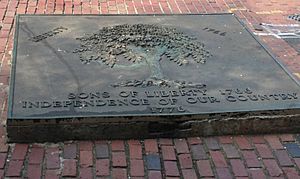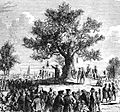Liberty Tree facts for kids
The Liberty Tree was a famous elm tree that stood in Boston before the American Revolution. In 1765, colonists in Boston used the tree to protest against the British government. It became a meeting spot for people who resisted British rule over the American colonies. The area around the tree was even called Liberty Hall. British Loyalists cut down the Liberty Tree in August 1775.
Contents
History of the Liberty Tree
Protests Against the Stamp Act
In 1765, the British government created the Stamp Act. This law made colonists pay a tax on all legal papers, newspapers, and even playing cards. People in the American colonies were very angry about this new tax. In Boston, a secret group of businessmen called the Loyal Nine started planning protests.
On August 14, 1765, a large crowd gathered under the elm tree in Boston. They were protesting the Stamp Act. From the tree, they hung a straw dummy that looked like Andrew Oliver. He was the colonist chosen by King George III to collect the tax. Next to the dummy, they hung a British army boot. This boot was a joke about two British leaders, the Earl of Bute and Lord George Grenville, who were blamed for the Stamp Act. This protest was the first big act of defiance against the British King. It helped start the resistance that led to the American Revolutionary War.
The tree became a main meeting place for protesters. The area around it was known as Liberty Hall. A special pole was put up nearby with a flag. Raising the flag would call the townspeople to a meeting. Ebenezer Mackintosh, a shoemaker, became known as "Captain General of the Liberty Tree" because he helped organize many protests. Paul Revere even showed the Liberty Tree in one of his famous pictures.
When the Stamp Act was canceled in 1766, people celebrated at the Liberty Tree. They decorated it with flags and lanterns. A copper sign was placed on the tree that read, "This tree was planted in the year 1646, and pruned by order of the Sons of Liberty, Feb. 14th, 1766." Soon, other towns across the colonies started naming their own "liberty trees." The Tree of Liberty became an important symbol of the American Revolution.
Other Important Protests
The Loyal Nine group later joined a larger group called the Sons of Liberty. They continued to use the Liberty Tree for their protests. Even a British Loyalist named Peter Oliver wrote that the tree was like an "idol" for the angry crowds. He said it was a place where people were judged for their political beliefs.
In 1768, during the Liberty Riot, people protested the British navy taking John Hancock's ship. They dragged a customs official's boat from the harbor all the way to the Liberty Tree. There, they held a fake trial and then burned the boat on Boston Common. Two years later, a funeral march for the victims of the Boston Massacre passed by the tree. It was also a site for protests against the Tea Act.
In 1774, a British customs official named John Malcolm was publicly punished near the tree. He was stripped, covered in tar and feathers, and forced to quit his job under the tree. The next year, Thomas Paine wrote a poem about the Liberty Tree.
As the war got closer, British soldiers made fun of the Liberty Tree. During the Siege of Boston, British soldiers and Loyalists cut the tree down. They knew how important it was to the American patriots. They used the wood for firewood. Later, American privateers (sailors with government permission to attack enemy ships) tried to get revenge on Nathaniel Coffin Jr., who helped cut down the tree.
After the British left Boston in 1776, patriots put up a liberty pole where the tree once stood. For many years, the tree's stump was a well-known landmark in Boston. In 1825, the Marquis de Lafayette, a French hero of the American Revolution, visited Boston. He said, "The world should never forget the spot where once stood Liberty Tree."
Memorials to the Liberty Tree
In 1964, a sculpture of the Liberty Tree was shown at the New York World's Fair. When the Liberty Tree Mall opened in 1972, the sculpture was placed inside.
In 1966, the Boston Herald newspaper wrote stories about how the Liberty Tree site was almost forgotten. The only marker was an old, dirty plaque from the 1850s. It was high up on a building and hidden by signs. A reporter named Ronald Kessler found that waitresses working right below the plaque didn't even know what the Liberty Tree was. One waitress joked that "Liberty Tree" was a sandwich!
Kessler convinced the Governor of Massachusetts, John A. Volpe, to visit the site. A photo of the Governor looking at the plaque from a fire truck ladder was on the front page of the newspaper. The Governor promised to create a park with monuments to remember the tree, but this promise was not kept for a long time.
In 1974, a small bronze plaque was placed in the sidewalk across the street from the old one. It reads, "SONS OF LIBERTY, 1766; INDEPENDENCE of their COUNTRY, 1776."
Finally, in December 2018, the city opened a proper plaza to honor the Liberty Tree. It's called Liberty Tree Plaza. It has tables, chairs, plants, lights, and even a new elm tree to remember the original. A stone monument tells the history of the Liberty Tree. It explains that the tree "became a rallying point for colonists protesting the British-imposed Stamp Act in 1765 and became an important symbol of their cause." It also says, "These 'Sons of Liberty' began the struggle that led to the Revolutionary War and American independence."
The Old State House museum in Boston has a piece of the flag that flew above the Liberty Tree. It also has one of the original lanterns that hung from the tree during the celebration when the Stamp Act was canceled.
Other Liberty Trees
Many other towns also named their own Liberty Trees. Most of these trees are gone now. However, Randolph, New Jersey has a white oak tree that they say dates back to 1720 and is a Liberty Tree. A very old tulip poplar tree stood at St. John's College in Annapolis, Maryland, until 1999. The Liberty Tree in Acton, Massachusetts, was an elm tree that lasted until about 1925. In 1915, students in Acton planted a "Peace Tree," which is a maple that still stands today.
The "Arbres de la liberté" (Liberty Trees) in France were inspired by the American example. They became a symbol of the French Revolution. The first one was planted in 1790. A liberty elm tree from around 1790 still stands in Faycelles, France. Liberty trees were also planted in Brussels and Amsterdam to celebrate alliances with the French Republic.
In India, Tipu Sultan supported French soldiers and planted a Tree of Liberty in Srirangapatna in 1797.
The Gernikako Arbola (Tree of Gernika) in the Basque Country has been a meeting place for people since the 1300s. This tree represents the traditional freedoms of the Basque people. Today, the president of the Basque Country takes his oath of office there.
In 1798, when the short-lived Roman Republic was formed, a liberty tree was planted in Rome. This marked the end of the Roman Ghetto. The last liberty elm in Italy, planted in 1799, stood until recently in Montepaone. It was damaged in a storm and has been replaced by a new tree grown from it.
The German philosophers Georg Hegel and Friedrich Schelling planted a liberty tree outside Tübingen, Germany, when they were students.
The term "Tree of Liberty" is also linked to a famous quote from Thomas Jefferson. In a 1787 letter, he wrote: "The tree of liberty must be refreshed from time to time with the blood of patriots and tyrants."
Images for kids




